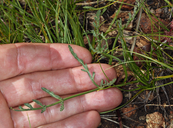Taxon Details
Lomatium tracyi
Tracy's lomatium
View Report Copy Link Calflora eFlora CCH CalPhotos iNaturalist
Taxon Summary:
Lomatium tracyi, commonly known as Tracy's lomatium, is a perennial herb in the Apiaceae that is found only in California. It occurs within Lower montane coniferous forest, and Upper montane coniferous forest, growing at elevations from 455 to 1950 meters. Lomatium tracyi is ranked 4.3, Plants of Limited Distribution, A Watch List; Not very threatened in California.|
Scientific Name: Lomatium tracyi Math. & Const. |
||
|
Common Name: Tracy's lomatium |
||
| Family: | Apiaceae | |
| Element Code: | PDAPI1B1Y0 | |
| USDA Plants Symbol: | LOTR | |
|
Synonyms/Other Names: |
||
| Name Status: |
JEF, FNA, POWO, IPNI, Tropicos |
|
| CA Rare Plant Rank: | 4.3 |
| Fed List: | None |
| State List: | None |
| Global Rank: | G4 |
|
State Rank: |
S4 |
| Other Status: | |
|
CRPR Changes: |
|
| Add Date: | 1974-01-01 |
| Date Edited: | 2025-06-03 |
| Lifeform: perennial herb | ||||||||||||||
Blooming Period: May-Jun
|
||||||||||||||
|
Elevation:
455 - 1950 meters 1495 - 6400 feet |
||||||||||||||
General Habitats:
|
||||||||||||||
| Microhabitat Details: | ||||||||||||||
Microhabitat:
|
||||||||||||||
| Threat List Total: | 0 | |
| Total EOs | % of EOs | |
| EOs with Threat Listed: | 0 | 0 % |
| THREAT LIST: | ||
|---|---|---|
| Total Occurrences: | 0 | ||||
| Element Occurrence Ranks: | |||||
|---|---|---|---|---|---|
| A | B | C | D | X | U |
| 0 | 0 | 0 | 0 | 0 | 0 |
| Occurrence Status: | |||||
|---|---|---|---|---|---|
| Historical >20 Years | 0 | ||||
| Recent <=20 Years | 0 | ||||
| Presence: | |||||
|---|---|---|---|---|---|
| Presumed Extant | 0 | ||||
| Possibly Extirpated | 0 | ||||
| Presumed Extirpated | 0 | ||||
| California Endemic: | |||||||||||||
| California Island: | |||||||||||||
|
States: Name (Code) California (CA) |
|||||||||||||
|
California Counties and Islands: Name (Code) Del Norte (DNT), Humboldt (HUM), Shasta (SHA), Siskiyou (SIS), Trinity (TRI) |
|||||||||||||
|
Quads: Name (Quad Code) Blue Creek Mtn. (4112347), Broken Rib Mtn. (4112386), Dubakella Mtn. (4012342), Grouse Mtn. (4012376), High Divide (4112481), Mumbo Basin (4112225), Pony Buck Peak (4012331), Scott Mountain (4112236), Smoky Creek (4012332), Tangle Blue Lake (4112226) |
|||||||||||||
Notes:
|
|||||||||||||
 Presumed Extant
Presumed Extant
Click on quad for name. Hold Shift Key to use mouse scroll wheel



